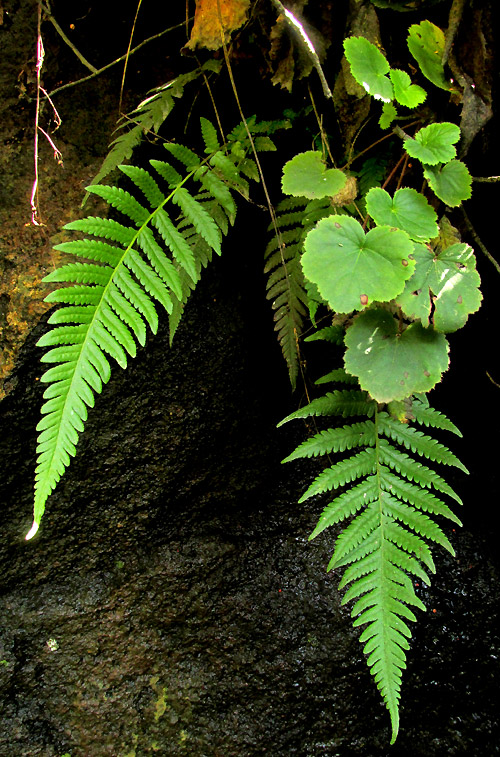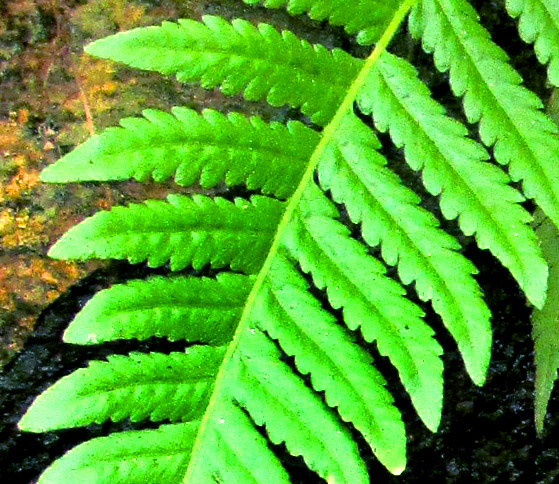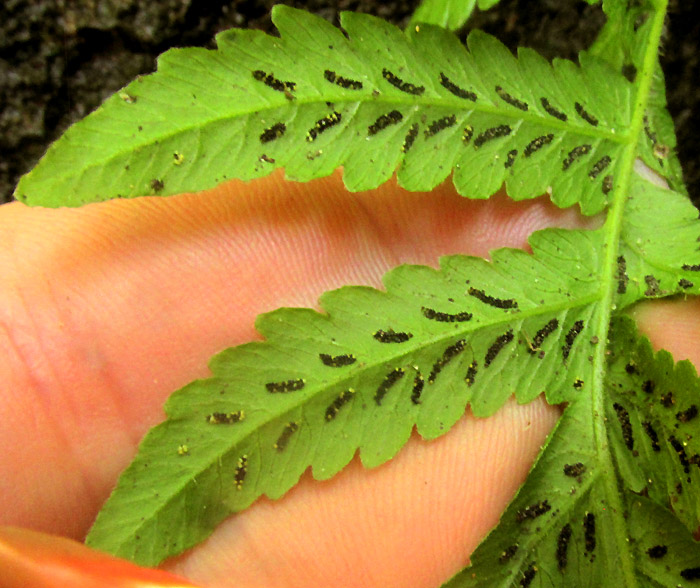Excerpts from Jim Conrad's
Naturalist Newsletter
Entry dated November 9, 2023, from notes taken near Cascadas de La Piedad waterfall 3kms NW of the community of San Pablo, municipality of Almeaco de Bonfil; in canyon of La Piedad below the falls; N20.1017°, W100.0041°, elevation 2360 meters (7750ft); extreme southern Querétaro state, MÉXICO
SILVERY GLADE FERN

The above fern dangling over a seep issuing from the canyon wall wasn't "supposed" to be here. It's another species thought of as occupying damp woods, often on lower slopes, in eastern North America. I can't find a record of its occurrence in Mexico, but we've seen numerous species in these cool, high mountains which more frequently occur in similar weather of the northern Temperate Zone. Also, fern spores are known to be dispersed over great distances. To be convinced of what this fern was, certain features were especially important to notice.

First, the habitat is perfect for this species. Also, note that the frond is once pinnately divided, with each section, or pinna, with shallowly scalloped margins. Pinnae toward the frond's tips fuse together at their bases, as seen at the right, but from about the frond's middle, pinnae toward the base become separated from one another. The frond is broadest at its middle, with pinnae diminishing in length both toward the tips and the bases. Especially notice how the lowest, very short pinnae swoop backwards toward the base.

It's the dark clusters of sporangia, the sori, however, that determine the identification. They're elongate, not round or horseshoe-shaped, and almost straight, but slightly hooked at their outer tips. There's just one for each pinna lobe. Nearly all pictures of this species' sori show them partially, often mostly, covered along their lower sides with thin, papery, silvery indusia. I'm unsure whether this fern's sori are not covered by indusia because the sori are mature and the spore-bearing sporangia have grown over the indusia -- to better release their spores -- or whether somehow the indusia have been removed, perhaps by hungry snails or insects. Are the white specks sprinkled over the dark sori indusia remnants?
There's just no fern species displaying all the above features which has no indusia, so definitely this fern's sori, unless it's some kind of mutant, normally would have indusia. Accepting that, our fern reveals itself as DEPARIA ACROSTICHOIDES, usually known as the Silver Glade Fern, native to eastern North America.
In 2021, Salvador González de León an others published a work entitled "Helechos Invasivos en México," considering forty-two fern species recognized as invasive in Mexico. Our Deparia acrostichoides wasn't mentioned. This suggests that the species is very rare here, possibly just arrived.
This species has jumped around, having been assigned to at least five different genera since it was first formally named in 1800, and older books are likely to use different names. I first learned it as a spleenwort in the genus Asplenium, but apparently its genes suggest otherwise.
In north America, in 1888, anthropologist James Mooney published Myths of the Cherokees, in which it was said that the fern we now call Deparia acrostichoides was used by the Cherokees medicinally, as a decoction, to produce vomiting.